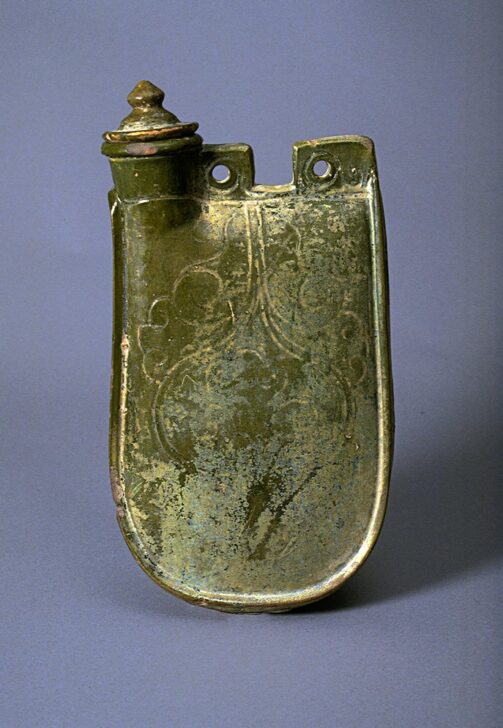Flask
Chinese

Description
Throughout history, China has been threatened by nomadic tribesmen on its northern borders. From the mid-tenth to the early twelfth centuries, one of these non-Chinese tribes, the Khitan, established a powerful state stretching from Inner Mongolia to the northeastern Liaoning peninsula. They developed a flourishing ceramic industry, drawing on vessel types that reflected their own traditional customs and the talents of captive Chinese potters. One result of this cultural encounter was the so-called “cockscomb vase,” which imitates the shape of the Khitan leather flask—an essential tool for life on horseback. The green lead glaze has calcified to a glassy silver on much of the vessel.
Maribeth Graybill, Senior Curator of Asian Art
Exhibited in "Flora and Fauna in Chinese Art," April 6, 2002 - December 1, 2002.
From the mid-tenth to the early twelfth centuries, the Khitan Liao, a sinicized tribe of Mongol origin, ruled over much of north China. So powerful was the Liao that the contemporary Chinese dynasty of Northern Song (960-1126) regularly sent tribute north to keep the peace.
Liao pottery borrows heavily from Tang and Northern Song models, but Liao ceramic production also shows an originality and vitality that reflects the cosmopolitan nature of Khitan culture, particularly in the area of vessel shape. Liao potters adopted shapes from objects made in other materials and from objects of West Asian and Middle Eastern origin. For example, the flask shaped vessel imitates the shape of leather bags used by the horse-riding Khitan to keep kumis, an alcoholic drink made from mare’s milk. The bag-shaped ovoid ewer topped with a spout to one side and a loop handle was also used as a wine flask. Its shape is loosely based on a Middle Eastern form made in metal, and ultimately the oenochoe wine jugs of ancient Greece.
(Label for UMMA Chinese Gallery Opening Rotation, March 2009)
Subject Matter:
This is a lead-glazed, cockscomb earthenware flask of the Khitan, Liao dynasty (907-1125).
Throughout history, China has been threatened by nomadic tribesmen on its northern borders. From the mid-tenth to the early twelfth centuries, one of these non-Chinese tribes, the Khitan, established a powerful state stretching from Inner Mongolia to the northeastern Liaoning peninsula. They developed a flourishing ceramic industry, drawing on vessel types that reflected their own traditional customs and the talents of captive Chinese potters. One result of this cultural encounter was the so-called “cockscomb vase,” which imitates the shape of the Khitan leather flask—an essential tool for life on horseback. The green lead glaze has calcified to a glassy silver on much of the vessel.
Physical Description:
This is an earthenware flask with a tall flattened body, short neck with direct rim to one side, and two peirced, flattened lugs for a strap handle. It is incised with a floral scroll on the body and has a domed lid with tall rim and pointed finial. It is covered in a green lead glaze with iridescence and calcification.
Usage Rights:
If you are interested in using an image for a publication, please visit https://umma.umich.edu/request-image/ for more information and to fill out the online Image Rights and Reproductions Request Form.